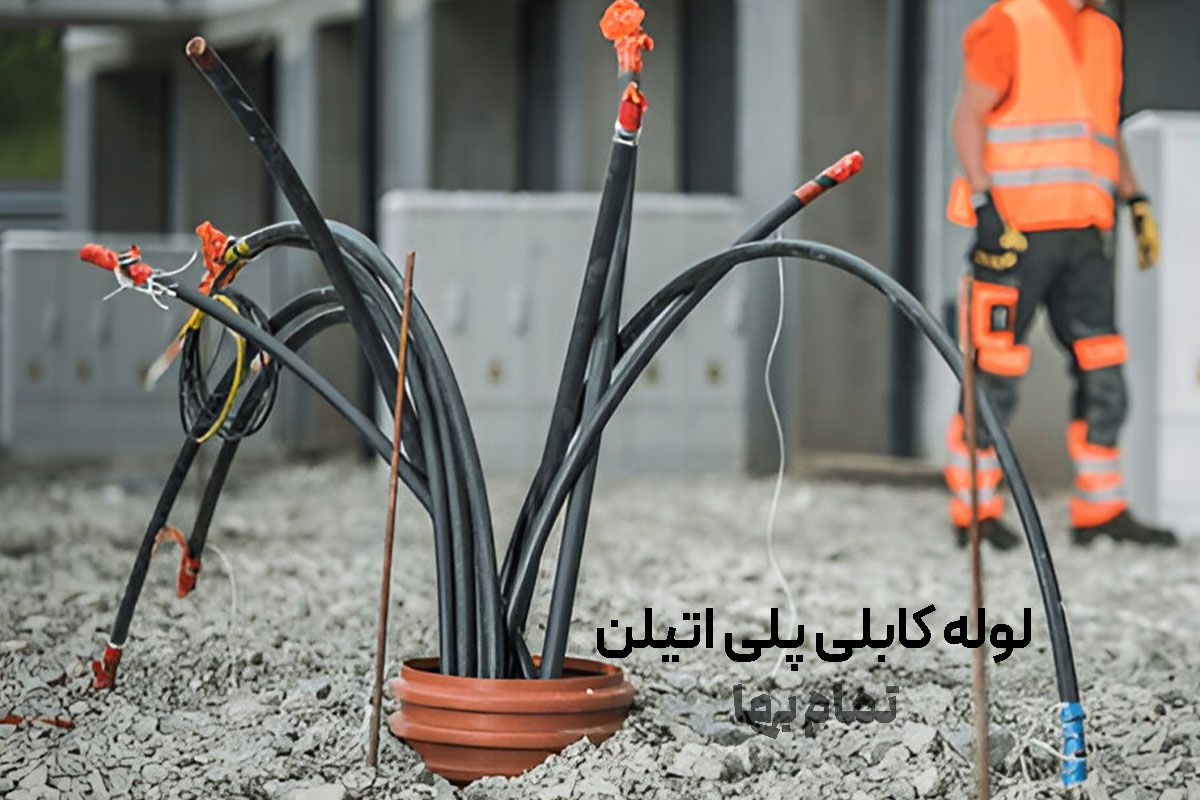Polyethylene cable conduit has, over the past two decades, become one of the primary solutions for protecting various telecommunications, fiber-optic, and power cables in urban and industrial infrastructure projects in Iran. Relying on the distinctive mechanical properties of high-density polyethylene (HDPE) and UV-stabilizing additives, this family of conduits delivers a very long service life in buried and exposed environments; thanks to low weight, their transport and installation are simpler, faster, and more cost-effective than metal and PVC pipes. The following provides a comprehensive review of technical details, standards, manufacturing process, and execution requirements for this product.
Structure and physico-chemical properties
The polyethylene used in cable conduits is primarily PE 80 or PE 100 grades with an average density of 0.94–0.96 g/cm³. The polymer’s chain macromolecules, through secondary van der Waals interactions, provide high impact flexibility; as a result, the pipe continues to operate without crack initiation from stress concentration and without brittle fracture. Adding a 2.5% black masterbatch containing carbon black increases UV resistance and enhances antioxidant properties.

Key advantages
- High flexibility: can be supplied in 100–500 m coils, reducing the number of joints.
- Chemical resistance: insoluble in most dilute acids and bases; suitable for areas contaminated by industrial effluents.
- Smooth inner surface: lowers cable-pulling friction and minimizes jacket damage.
- Intrinsic electrical insulation: prevents stray-current induction and electrolytic corrosion.
Common dimensional specifications and working pressure
| Outside diameter (mm) | Nominal wall (mm) | Allowable pressure (bar) | Typical application |
|---|---|---|---|
| 20 | 1.6 | 4 | Street lighting and CCTV |
| 32 | 2.4 | 6 | Urban fiber optics (FTTx) |
| 50 | 3.0 | 8 | Low-voltage power network |
| 90 | 5.4 | 10 | Intercity telecom lines |
| 110 | 6.6 | 12.5 | Rail underpasses and highways |
Production process and extrusion-line quality control
- Raw-material compounding: polyethylene resin, black masterbatch, and antioxidant are fed gravimetrically to the extruder.
- Single- or multilayer extrusion: the internal ring–barrel die forms precise dimensions. In multilayer types, a colored outer layer can be added for application coding (orange for telecom, red for power).
- Calibration and cooling: a vacuum tank at 0.8 bar stabilizes the OD; then a spray-water tank brings pipe temperature below 40 °C.
- Haul-off and cutting: a belt haul-off with servo control maintains uniform speed, and a CNC planetary (ring) saw cuts to defined lengths.
- Online tests: laser diameter/ovality sensor, ultrasonic thickness gauge, and a spark-tester trough report point defects in-line.
Mandatory standards and technical tests
| Reference standard | Test domain | Test objective |
|---|---|---|
| EN 12201-2 | Hydrostatic strength at 80 °C/165 h | Ensure long-term pressure durability |
| IEC 61386 | Impact and crush resistance | Assure soil and traffic load tolerance |
| ISIRI-11233 | Water and moisture ingress | Preserve the cable’s dielectric properties |
| ISO 6259 | Rapid crack test | Prevent crack growth at scratches |
| ASTM F2160 | Tensile and minimum bend radius | Verify coiling/rolling capability without kinking |
Installation, trenching, and bend radius
- Trench width: OD × 6 for single-row and × 10 for multi-row layouts alongside medium-voltage power cable.
- Burial depth: minimum 70 cm in light-traffic areas and 90 cm on highways to avoid axial load effects.
- Permissible bend radius: 15 × OD at 20 °C ambient; in cold weather (below 5 °C) increase to 25 × OD.
- Bedding: 10 cm of washed sand graded 0–6 mm below and above the pipe, then compacted backfill.
Comparison with PVC, metal, and GRP conduits
Service life
Polyethylene with an MRS index above 10 MPa under buried conditions has a design life of at least 50 years; meanwhile PVC becomes brittle under sunlight, and steel pipes in acidic soils require epoxy coating and cathodic protection.
Execution speed
Long-coil HDPE cable conduit reduces the number of electrofusion joints by up to 70% compared with rigid 6-m GRP pipes.
Life-cycle cost
Although HDPE’s price per kilogram is higher than PVC, eliminating numerous fittings, heavy-handling equipment, and periodic replacement reduces total project cost by 15–20%.

Maintenance and periodic inspection requirements
- Access-chamber inspection: every 12 months, check contamination and water accumulation at branching nodes.
- Guide-rope pull test: in fiber-optic lines, keep the existing guide-rope tension below 40 kgf to avoid excess stress on the cable jacket.
- Soil-corrosion monitoring: if the conduit is near steel pipelines, measure soil resistivity and install magnesium sacrificial anodes if stray currents are present.
Buying guide, transport, and storage
- Grade selection: for inner-city projects with tight bends, PE 80 is sufficient; for HDD (horizontal directional drilling), use PE 100 with high ESCR.
- Marking: meter-by-meter length marks on the pipe; embossed manufacturer name, polymer grade, production standard, and date are mandatory.
- Storage conditions: store coils away from direct sunlight and temperatures above 40 °C on wooden racks with at least three supports.
Key industries and reference projects
- 5G rollout projects of MCI and MTN Irancell in major cities
- National fiber-optic backbone (Chabahar–Birjand corridor)
- Power facilities of South Pars Special Economic Zone refineries
- Surveillance systems for Isfahan and Shiraz metro lines
Tamam Baha’s role in the HDPE cable-conduit supply chain
As one of Iran’s long-standing MEP suppliers, Tamam Baha offers a complete range of HDPE cable conduits in 20–110 mm sizes from reputable domestic and imported brands and, with custom cutting, electrofusion welding, and pre-purchase technical support, serves telecom and power project owners and contractors across Iran and the wider region.
